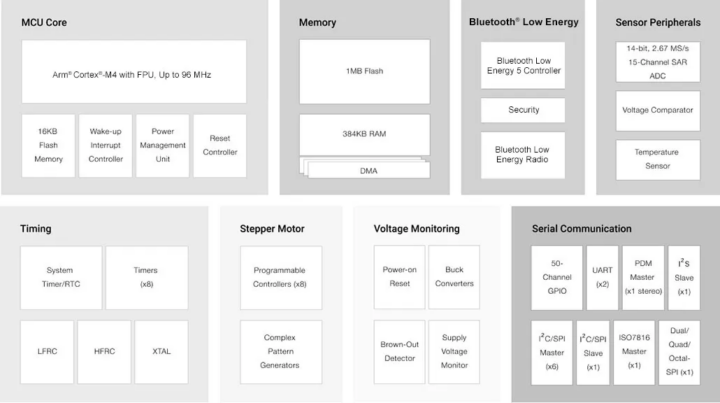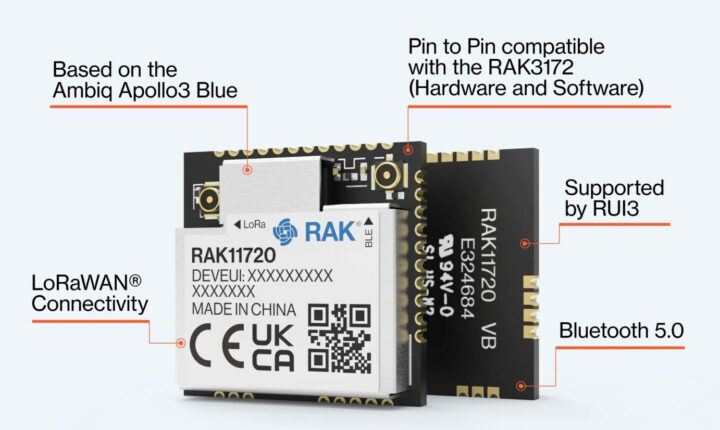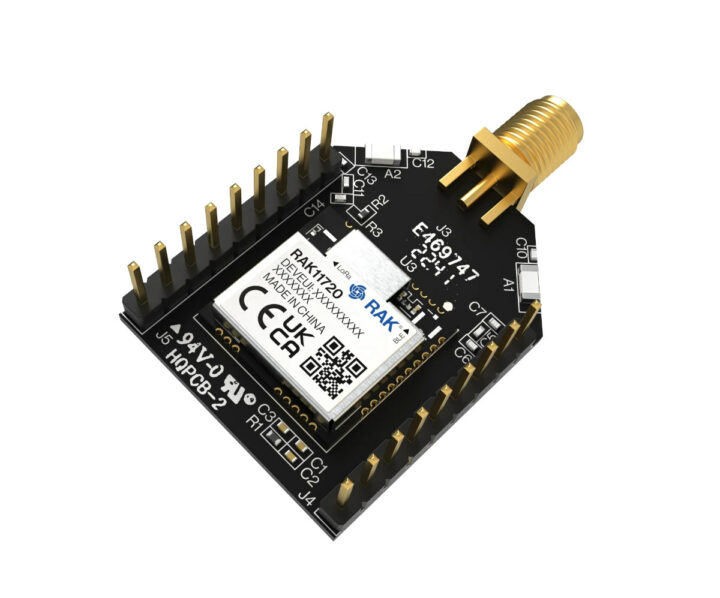RAKwireless WisDuo RAK11720 is a LoRaWAN and Bluetooth LE (module) equipped with Ambiq Apollo3 ultra-low-power BLE 5.0 microcontroller and a Semtech SX1262 LoRa transceiver.
The Wisduo RAK11720 is pin-to-pin compatible with the STM32WL-based Wisduo RAK3172 LoRaWAN module, and provides an easy upgrade path for IoT applications that require Bluetooth LE connectivity and more memory.
WisDuo RAK11720 specifications:
- MCU – Ambiq Apollo3 Blue AMA3B1KK-KBR-B0 Arm Cortex-M4F microcontroller locked at up to 96 MHz with 1MB flash, 348 SRAM, Bluetooth LE 5.0, and an active power consumption of less than < 6 μA/ MHz
- LoRa
- Semtech SX1262 sub-GHz radio transceivers
- LoRaWAN 1.0.3 specification compliant
- Supported bands: EU433, CN470, IN865, EU868, AU915, US915, KR920, RU864, and AS923-1/2/3/4
- LoRaWAN activation via OTAA/ABP
- LoRa Point-to-Point (P2P) communication
- Long-range – greater than 15 km with optimized antenna
- Antennas – 2x IPEX antenna connectors or RF pads for LoRa and Bluetooth
- I/O expansion – UART, I2C, SPI, ADC, GPIO
- Supply Voltage – 1.8 V ~ 3.6 V
- Power consumption – 2.37 μA in sleep mode
- Dimensions – 15.5 x 15 x 3.5 mm
- Temperature Range – -40° C ~ 85° C
The module can be programmed with an AT command set via its UART interface and is also supported by the RUI3 (RAK Unified Interface v3) firmware development framework that allows the development of one application to be deployed on any supported microcontrollers such as STM32, Apollo3 Blue, ESP32, Nordic nRF52, Raspberry Pi RP2040, etc… You’ll find more technical details including the datasheet and the AT command set in the documentation.

The Ambiq microcontrollers integrate the company’s Subthreshold Power Optimized Technology (SPOT) which enables the MCU to run at low voltage (less than 0.5V) as we’ve discussed in our coverage of the Apollo2 Blue and Apollo4 microcontrollers, so I was expected the WisDuo RAK11720 to consume less power than the WisDuo RAK3172. But it looks like having a two-chip solution has its cost in terms of power consumption because the RAK11720 consumes 2.37 μA in sleep mode, but the RAK3172 only 1.69 μA. The WisDuo RAK11720 also offers a smaller and cheaper alternative to the $15 RAK4630 WisDuo Stamp module with LoRaWAN (SX1262) and BLE 5.0 (nRF52840) with very similar features.
The WisDuo RAK11720 LoRaWAN & Bluetooth LE module is available now for $7.99, and for comparison, the Wisduo RAK3172 LoRaWAN only module goes for $5.99. But for evaluation, you may want to get the $18 RAK11720 breakout board that exposes the module’s I/Os and provides an SMA antenna connector for LoRaWAn and a ceramic antenna for BLE.

Jean-Luc started CNX Software in 2010 as a part-time endeavor, before quitting his job as a software engineering manager, and starting to write daily news, and reviews full time later in 2011.
Support CNX Software! Donate via cryptocurrencies, become a Patron on Patreon, or purchase goods on Amazon or Aliexpress. We also use affiliate links in articles to earn commissions if you make a purchase after clicking on those links.






A little odd that they use an Apollo, given that the LoRa radio will consume so much energy to operate …
Apollo is used as a processor + BLE configuration and LoRA uplink for long range. If the LoRA hardware is shut down it consumes <1uA. Depends really on the use-case and how people want to use the module. I dont think its suitable as a coin cell device though like a BLE only device would.
I think I understand. Basically the special feature of Apollo (Subthreshold Power Optimized Technology (SPOT)) is wasted. It could be a price or parts shortage reason as to why Apollo was chosen over Nordic.